Tools Required
J 43653 Flywheel Holding Tool
- Disconnect the negative battery cable. Refer to Battery Negative Cable Disconnection and Connection in Engine Electrical.
- Disconnect the air inlet duct hose from the intake plenum.
- Disconnect the transaxle wiring harness from the transaxle and the PNP switch.
- Remove the upper transmission to engine bolts and stud.
- Install the engine support fixture. Refer to Engine Support Fixture in Engine Mechanical - 2.2L (L 61).
- Raise and support the vehicle. Refer to Lifting and Jacking the Vehicle in General Information.
- Remove the front wheel and tire assemblies. Refer to Tire and Wheel Removal and Installation in Tires and Wheels.
- Remove the both front fender liners. Refer to Front Fender Liner Replacement in Body Front End.
- Remove the steering gear mounting bolts and secure the steering gear with mechanics wire.
- Disconnect the wheel speed sensor wires from the both front wheels and unclip from the frame.
- Separate the ball joints from the steering knuckles. Refer to Lower Control Arm Ball Joint Replacement in Suspension-Front Suspension.
- Remove the frame. Refer to Front Frame Replacement in Frame and Underbody.
- Remove the 2 bolts from the transmission brace.
- Disconnect the shift cable from the shift linkage.
- Disconnect the cable from the bracket.
- Remove the flywheel inspection cover.
- Remove the starter. Refer to Starter Motor Replacement in Engine Electrical.
- Mark the relationship of the flywheel to the torque converter for reassembly.
- Use the J 43653 to prevent the crankshaft from rotating.
- Use J 43653 to remove the torque converter to flywheel bolts.
- Remove the transmission cooler lines by removing the nut holding the bracket to the transaxle case.
- Disconnect the VSS wiring harness from the sensor.
- Disconnect the wheel drive shafts from the transaxle. Refer to Wheel Drive Shaft Replacement in Front Wheel Drive Shafts
- Lower the vehicle.
- Remove the body to transmission mount bolts.
- Lower the transmission with the engine support fixture enough to remove the transmission.
- Raise the vehicle.
- Remove the oil pan to drain the transmission. Refer to Oil Pan Replacement .
- Install the oil pan. Refer to Oil Pan Replacement .
- Support the transmission with a suitable jack.
- Remove the transaxle to engine nut.
- Separate the engine and the transaxle.
- Remove the transaxle from the vehicle.
- Remove the PNP switch.
- Remove the shifter cable bracket.
- Remove the lower transmission to engine stud.
- Remove the transmission mount.
- Flush the transmission cooler and lines. Refer to Transmission Fluid Cooler Flushing and Flow Test .
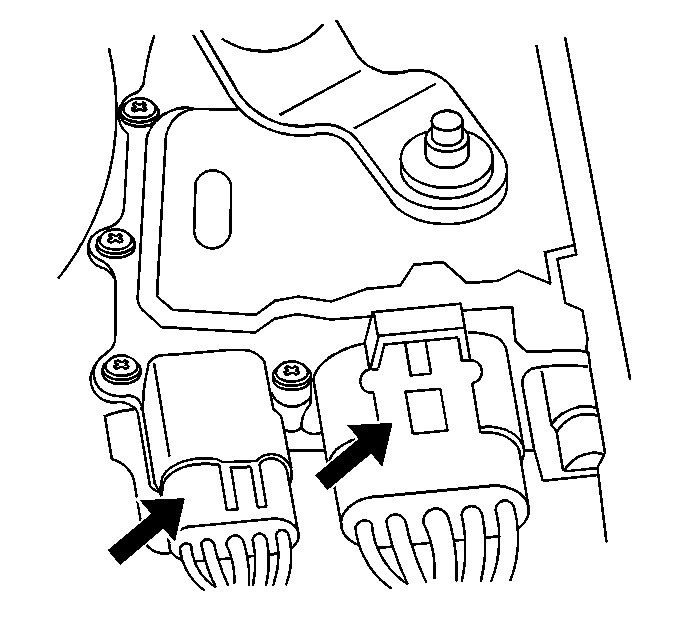
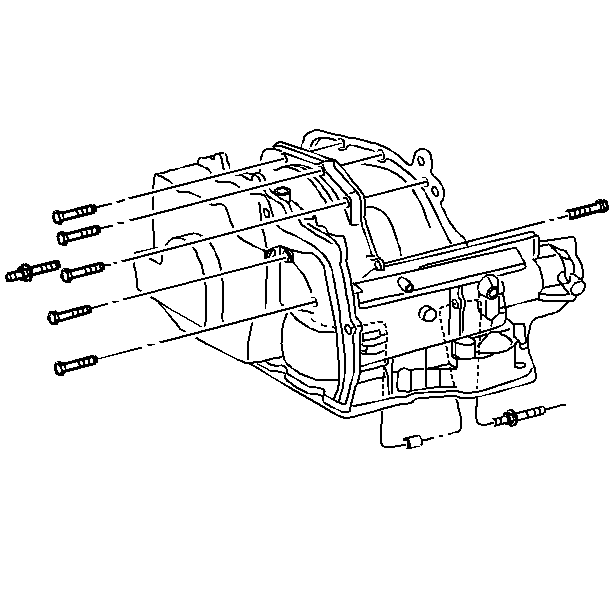
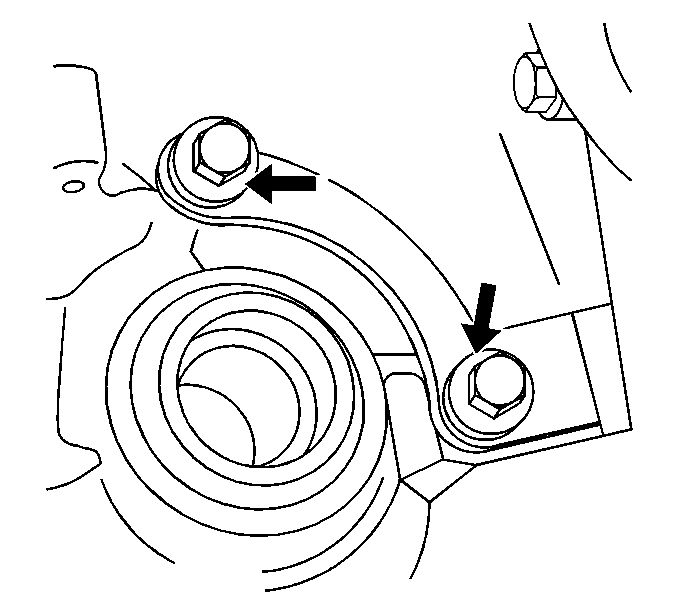

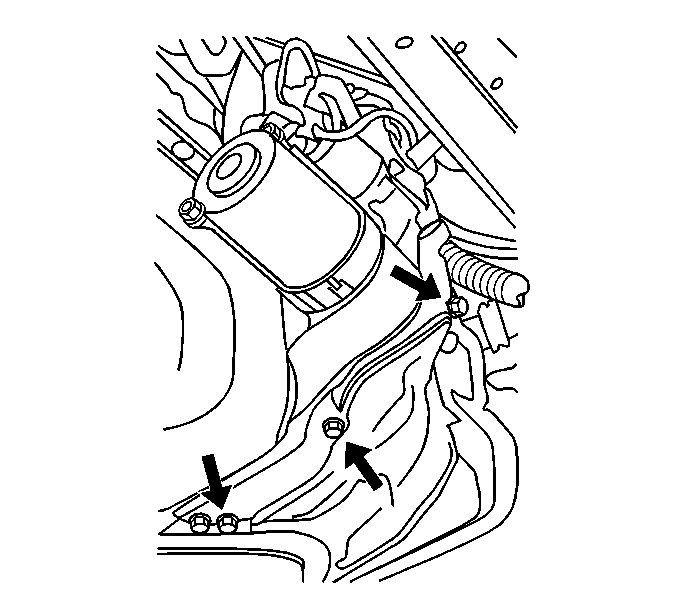
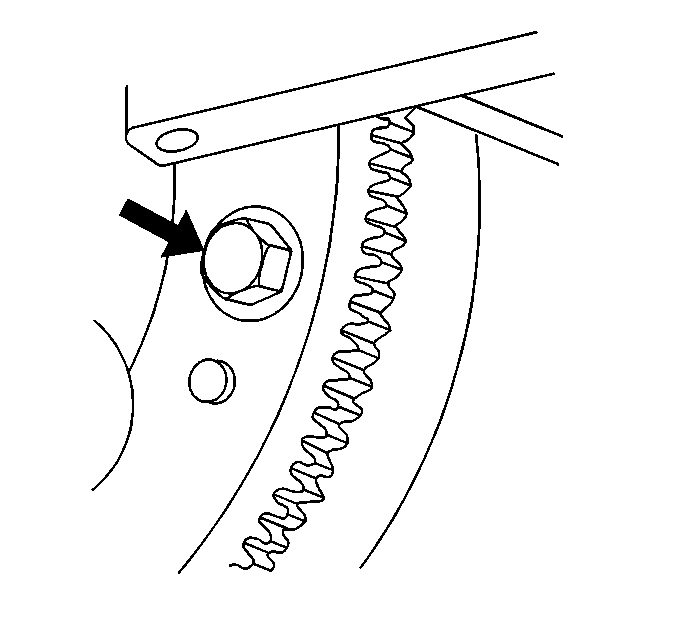

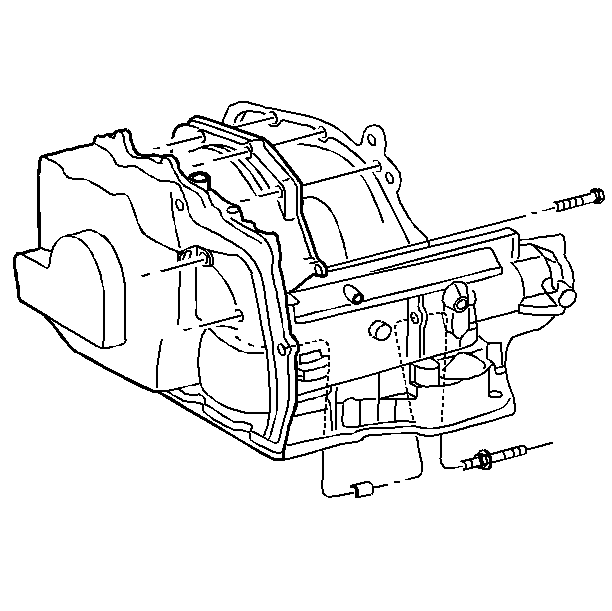
Installation Procedure
- Install the PNP switch.
- Install the shifter cable bracket.
- Install the lower transmission to engine stud.
- Install the transmission mount.
- Position the transaxle in the vehicle.
- Install the lower transmission to engine bolts and nuts.
- Connect the transaxle cooler pipes to the transaxle.
- Use the J 43653 to prevent the crankshaft from rotating.
- Install the torque converter to flywheel bolts.
- Install the wheel drive shafts to the transaxle. Refer to Wheel Drive Shaft Replacement in Front Wheel Drive Shafts.
- Connect the wiring harness to the VSS.
- Install the starter. Refer to Starter Motor Replacement in Engine Electrical.
- Install the flywheel inspection cover bolts.
- Lower the vehicle.
- Use the engine support fixture to raise the engine and transmission assembly.
- Install the transaxle mount to body bolts.
- Raise the vehicle.
- Install the frame. Refer to Front Frame Replacement Frame and Underbody.
- Connect the ball joints to the steering knuckles. Refer to Lower Control Arm Ball Joint Replacement in Front Suspension.
- Route and clip the wheel speed sensor wiring into the proper position on both sides.
- Install the steering gear to the front suspension crossmember.
- Install the steering gear bolts to the front suspension crossmember.
- Install the transmission to engine brace bolts.
- Install the both front fender liners. Refer to Front Fender Liner Replacement in Body Front End.
- Install the front wheel and tire assemblies. Refer to Tire and Wheel Removal and Installation in Tires and Wheels.
- Lower the vehicle.
- Install the upper transmission to engine bolts and stud.
- Install the engine wiring harness grounds to the transaxle to engine mount stud and nut.
- Remove the engine support fixture. Refer to Engine Support Fixture in Engine Mechanical - 2.2L (L61).
- Install the shift linkage to the transmission.
- Connect the electrical connectors to the PNP switch and transaxle.
- Connect the air duct hose to the intake plenum.
- Connect the negative battery cable. Refer to Battery Negative Cable Disconnection and Connection in Engine Electrical.
- Inspect the transmission fluid level.
- Reset the TAP values. Refer to Transmission Adaptive Functions .


Notice: Use the correct fastener in the correct location. Replacement fasteners must be the correct part number for that application. Fasteners requiring replacement or fasteners requiring the use of thread locking compound or sealant are identified in the service procedure. Do not use paints, lubricants, or corrosion inhibitors on fasteners or fastener joint surfaces unless specified. These coatings affect fastener torque and joint clamping force and may damage the fastener. Use the correct tightening sequence and specifications when installing fasteners in order to avoid damage to parts and systems.
Tighten
Tighten the bolts and nuts to 90 N·m (66 lb ft).
Tighten
Tighten the cooler pipes to 8 N·m (71 lb in).

Tighten
Tighten the torque converter bolts to 62 N·m (46 lb ft).


Tighten
Tighten the bolts to 10 N·m (89 lb in).
Tighten
Tighten the bolts to 90 N·m (66 lb ft).
Tighten
Tighten the bolts to 110 N·m (81 lb ft).

Tighten
Tighten the bolts to 72 N·m (53 lb ft).

Tighten
Tighten all of the bolts to 90 N·m (66 lb ft).
Tighten
Tighten the nut to 8 N·m (71 lb in).


Important: It is recommended that transmission adaptive pressure (TAP) information be reset.
Resetting the TAP values using a scan tool will erase all learned values in all cells. As a result, The ECM, PCM or TCM will need to relearn TAP values. Transmission performance may be affected as new TAP values are learned.